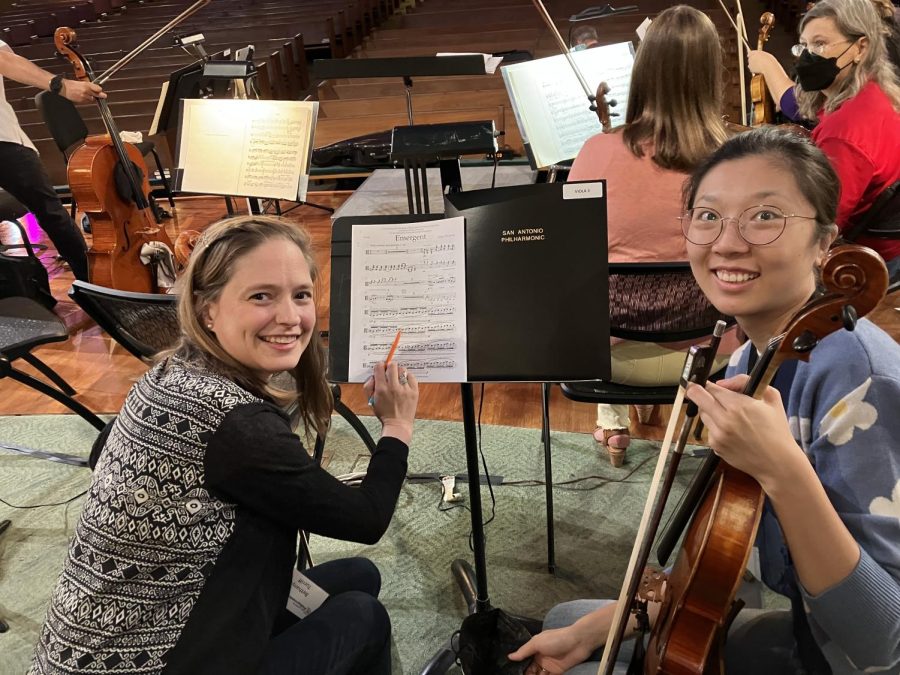UTSA professor part of new San Antonio Philharmonic
Photo courtesy of Allyson Dawkins
Philharmonic violists Bethany Turriff and Wanlin Cui pose for a photo during practice.
October 11, 2022
After reaching a deadlock in labor negotiations between the Symphony Society of San Antonio and the local chapter of the American Federation of Musicians, the San Antonio Symphony was officially dissolved on Thursday, June 16. The Symphony’s Board of Directors announced the dissolution via a statement posted to their Facebook Page. Along with this, the Board also filed for bankruptcy.
As previously reported by The Paisano, negotiations between the Symphony’s management and its musicians led to the latter going on a months-long protest. The protest occurred as a result of a proposed contract that would let go off around 20 players and introduce a severe pay cut.
Following the dissolution, musicians from the former Symphony regrouped to form the San Antonio Philharmonic. According to the San Antonio Report, the new group formed from the Musicians of the San Antonio Symphony (MOSAS) performance fund — the nonprofit created after the Symphony went on strike last year.
“At that time, right when the bankruptcy happened, we were still operating as MOSAS — Musicians of the San Antonio Symphony — but when we decided to move forward, several names were proposed and we voted on it and the name San Antonio Philharmonic was chosen, which I really love. I think it doesn’t have any baggage with it other than the name San Antonio. To me, it’s like, Philharmonic sounds even fancier than Symphony,” Allyson Dawkins, associate professor of practice at UTSA, said.
Dawkins was the symphony’s principal violist and is now a member of the newly formed Philharmonic. According to Dawkins, all musicians that had a contract with the Symphony were offered a spot in the Philharmonic, and the Philharmonic currently has eight members on its board.
“We were all invited to make suggestions [about Board members] and I made several,” Dawkins said. “And they … just have to kind of vet them — talk to them, find out if they’re really interested in being on the board or not. Being on the board is … it’s a big job, it’s a big commitment. I’m the president of the Board of the San Antonio Chamber Music Society and it’s a volunteer job and it’s a big job. It takes up a lot of my time. So you have to really have fire in the belly about the organization [and] be willing to serve because you’re responsible.”
Dawkins explained that one of the key tasks required of the Board members for the Philharmonic is to bring in funding for the group.
“Their main job is to raise money because in the performing arts, [especially] in the symphonic world, 100% of the budget is not made by selling tickets to concerts. That’s usually 40% of the budget. [So] 60% is gifts,” Dawkins said.
The formation of the Philharmonic has come with a sense of relief after months of worrying about the future of the Symphony. Dawkins also expressed the apprehension that came with discussing the issue with peers from around the country.
“Once we just got onto the business of making music and I didn’t have to worry about raising money or anything, my only job was to play the viola. And it was really a relief and really healing,” Dawkins said.
As a professor at UTSA, Dawkins also spoke to the impact that the situation had on students and how the formation of the Philharmonic was a relief for them as well.
“[The students are] excited … I think their concern was born out of the stress that they saw all their teachers under,” Dawkins said. “Certainly, everybody feels better, so they sense the relief.”
According to Dawkins, all members of the Symphony that joined the Philharmonic are getting the same salary they got before labor negotiations with the management began last year. However, members of the Philharmonic still do not have access to benefits, and members have to get their own instrument insurance and healthcare.
“We don’t have benefits yet,” Dawkins said. “The board is very much wanting to negotiate a collective bargaining agreement, also called a CBA. And healthcare benefits are expensive, so we’re just step-by-step working on it.”
As the Philharmonic continues to adjust to and navigate through this transition, Dawkins expressed hope that the group will receive wider acceptance from the San Antonio community.
“I hope that it will become an organization [that] all of San Antonio can embrace and trust and not feel that it is elitist, and that the people who can support it will be willing to support it,” Dawkins said.
The San Antonio Philharmonic currently plays at the First Baptist Church, a location close to the Tobin Center where the San Antonio Symphony held performances before its dissolution. The Philharmonic’s first performance as a group took place on Friday, Sept. 16.
For more information about the Philharmonic, including future events, visit their website at https://saphil.org/.
The interview for this article was done by Bella Nieto







